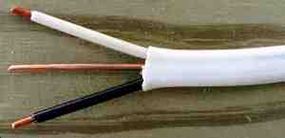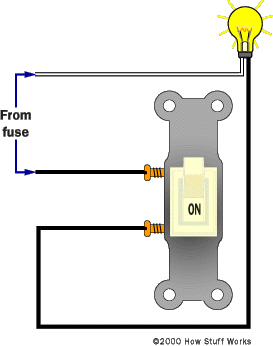Normal Lights
Let's start by looking at how a normal light is wired so that you can understand basic residential wiring for a light switch. The figure below shows the simplest possible configuration:
In this diagram, the black wire is "hot." That is, it carries the 120-volt AC current. The white wire is neutral. (For more information on household AC current and grounding, see How Power Distribution Grids Work.) You can see in the figure that the current runs through the switch. The switch simply opens (off) or closes (on) the connection between the two terminals on the switch. When the switch is on, current flows along the black wire through the switch to the light, and then returns to ground through the white wire to complete the circuit.
Advertisement
The electrician who wires the house normally uses non-metallic sheathed cable, which most people know by the brand name Romex, to run power from the fuse box to the switches and outlets in the house. A piece of this cable is shown here:

This cable consists of an outer plastic sheath (white in this picture) with three wires inside. The black and white wires are insulated, while a bare, third wire acts as the grounding wire for the circuit. Most normal household applications use 12- or 14-gauge cable.
